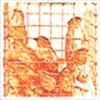 Martyn Bates' elusive work as Migraine Inducers issued before his involvement with Eyeless in Gaza finally gets released on CD. Originally circulated on cassette in a tiny quantity as Dissonance/Antagonistic Music in 1979, it later saw a marginally wider release in the United States in somewhat abbreviated form. The complete version of this legendary album is included here, as is a second disc recorded in 1994 with Gaza partner Peter Becker to complete the work.
Martyn Bates' elusive work as Migraine Inducers issued before his involvement with Eyeless in Gaza finally gets released on CD. Originally circulated on cassette in a tiny quantity as Dissonance/Antagonistic Music in 1979, it later saw a marginally wider release in the United States in somewhat abbreviated form. The complete version of this legendary album is included here, as is a second disc recorded in 1994 with Gaza partner Peter Becker to complete the work.
Although released in a small quantity, it did not go unnoticed. In fact, an early fan was Geoff Rushton, who wrote of it in Stabmental as "violent, anti-music" and even asked permission to use some of it for a "suicide performance." Haunting and gritty, this music may surprise Gaza fans accustomed to melody and structure. Bates himself called this work a "scream of frustration," and the description is apt.
Using things like electric guitar, food blender, chair springs, various percussion, motors, marbles, radio, and voice, Bates creates a howling and rusty landscape unlike anything heard before. Tape manipulation, loops, and effects further splinter the chaos. At times it sounds like Bates is disemboweling his instruments, evincing every last sound they're capable of producing like a shaman practicing a maddening form of divination through technological evisceration. When his voice appears, it is masked and mutated beyond recognition, pared down to its most primal parts. Even so, Bates isn't above throwing in bits of melody with electronics or his guitar, yet these respites are brief, only serving to create a longing for structure that's never adequately resolved. Bates further confounds listeners by not giving the tracks any definitive titles. Although he gives evocative suggestions such as "Child Squashing Frog," "Mona Lisa's Sister and Subsequent Burning," or "Dead Seahorse With Sky Melting," the nine listed titles do not nearly cover the 21 tracks found on the first disc alone. Clearly, the music is open to interpretation even as it sets the imagination on fire.
Becker helped Bates complete another version of Dissonance in 1994, included here as a second disc. Technological advances don't overshadow the intent of the original, if they're even utilized at all, and the duo do a remarkable job of unlearning or forgetting all of their musical accomplishments as EIG. The terrain they cover here is similar to Bates' original, if a bit more studied and patient in places, yet it surprisingly recalls the previous work quite accurately considering that 15 years had passed since the original. While the yearning for some sort of closure is a different creative impulse than that which sparked the original, the harrowing results are much the same.
Despite their limitations in fidelity, these recordings still sound as fresh and bizarre as anything I've heard in years. Now that they're available to a wider audience, Bates' reputation as an innovator and restless investigator of sound is more deserved than ever.
samples:
Read More

